

Matt Robinson
2026 Skoda Fabia 130 review: Quick drive
56 Minutes Ago
Sure the RS6 is more practical, but the RS7 is gorgeous, face-meltingly quick, and built like a Swiss watch. It's the slinky four-door supercar that dreams are made of.
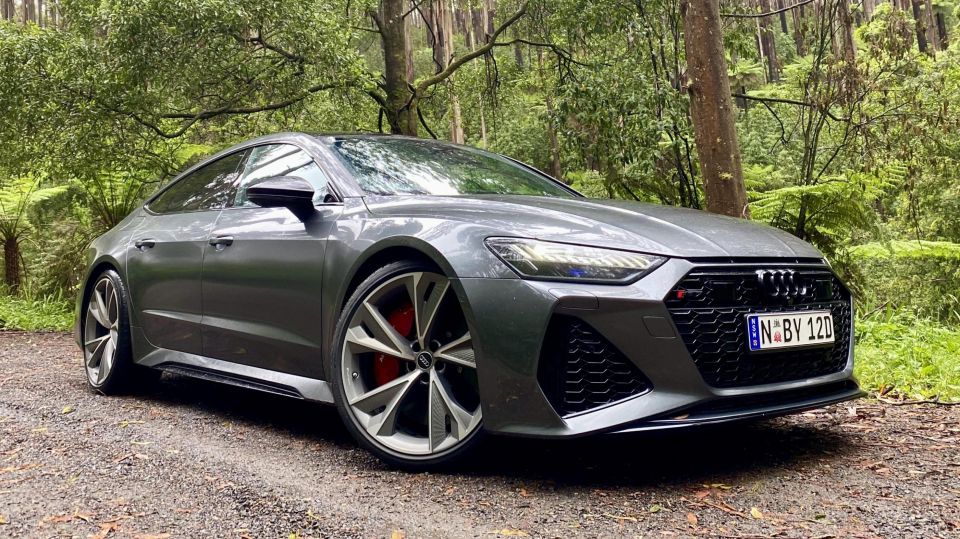
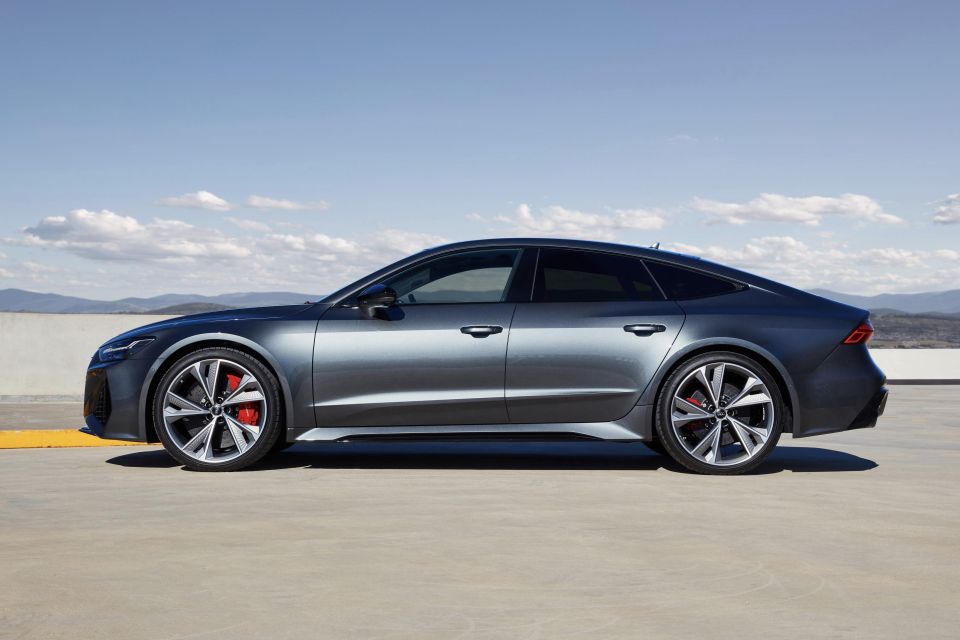

Senior Contributor
New from
$224,000
excl. on-roads

Senior Contributor
New from
$224,000
excl. on-roads


Senior Contributor
New from
$224,000
excl. on-roads

Senior Contributor
New from
$224,000
excl. on-roads
Quickly see how this car stacks up against its competition. Select any benchmark to see more details.
Where expert car reviews meet expert car buying – CarExpert gives you trusted advice, personalised service and real savings on your next new car.
Motoring writers invariably hold the Audi RS6 Avant in the very highest esteem. Invariably it makes most scribes’ lists of perfect daily drivers, thanks to its practicality and performative potency.
But for me there’s something extra special about the new, mechanically identical RS7 Sportback that arrived alongside its wagon sibling in July this year. Not as spacious as the Avant perhaps, but perfectly proportioned in the way only a four-door GT can be.
From every angle it conveys a message of beauty and brawn incarnate. For what it’s worth, over the course of a week at the wheel it drew more covetous glances and car-park conversations from passersby than anything else I drove in 2020.

The list price is $224,000 plus extra on-road costs including stamp duty and dealer delivery. Incidentally this includes about $36,000 of luxury car tax, with Audi’s website listing the actual vehicle price as $188,170.
The RS7’s price tag is $8000 higher than the RS6 Avant’s price tag, which offers more room for less money. Then again, the previous model RS7 cost $238,500 when it launched back in 2013, so this new one is a bit of a bargain by comparison.
To give the RS7’s pricing some further context, the similarly sized BMW M8 Competition in its four-door incarnation costs $354,900. This Bavarian beast is about the same size as the RS7, and its V8 has 19kW more power but 50Nm less torque.
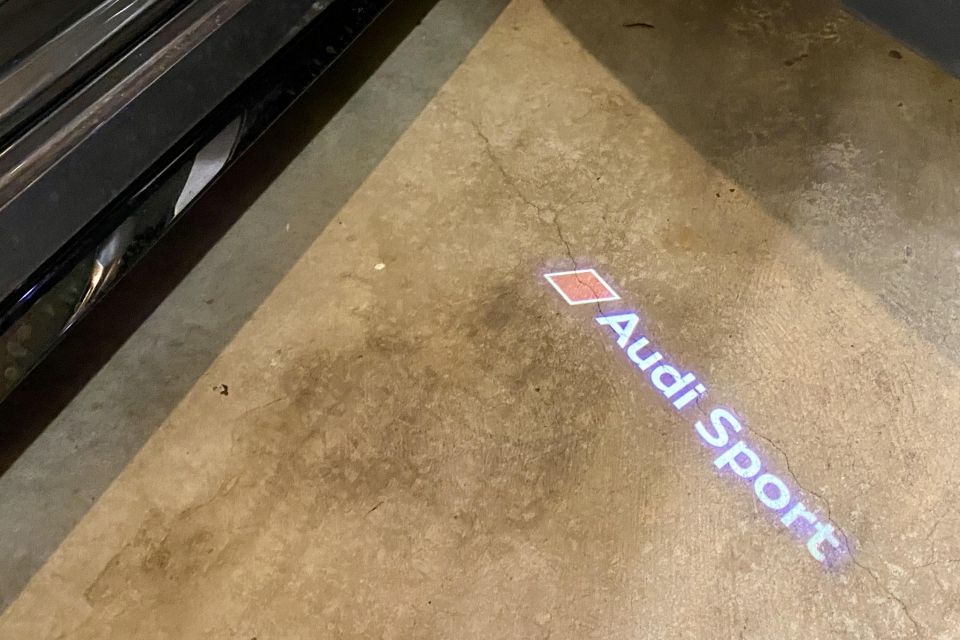
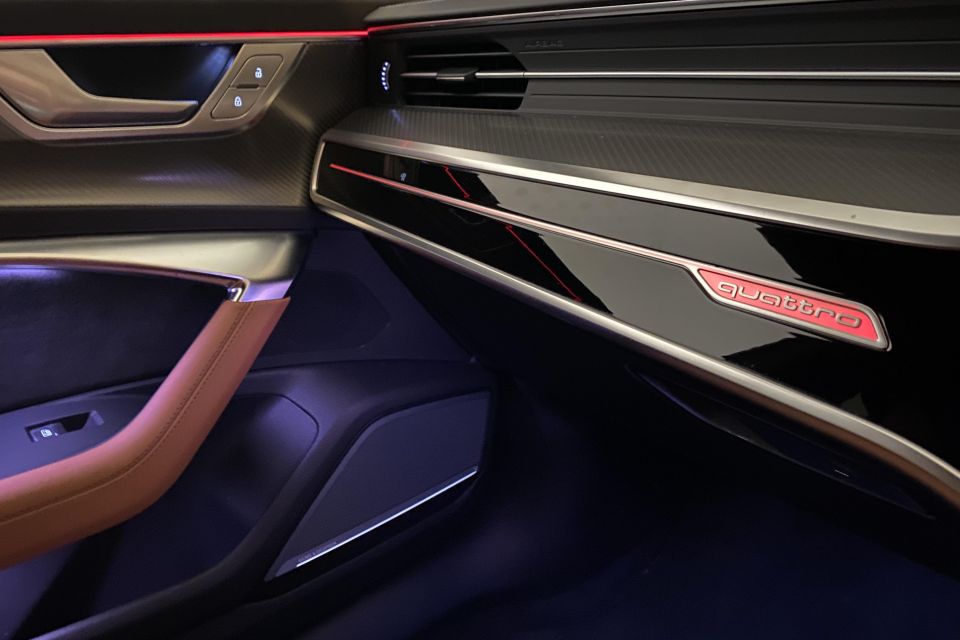
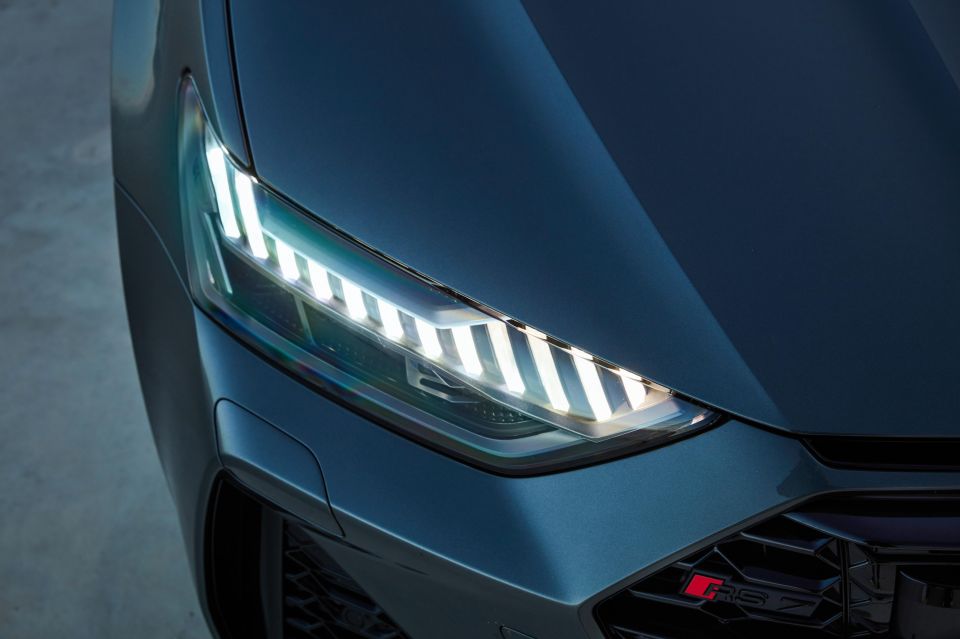
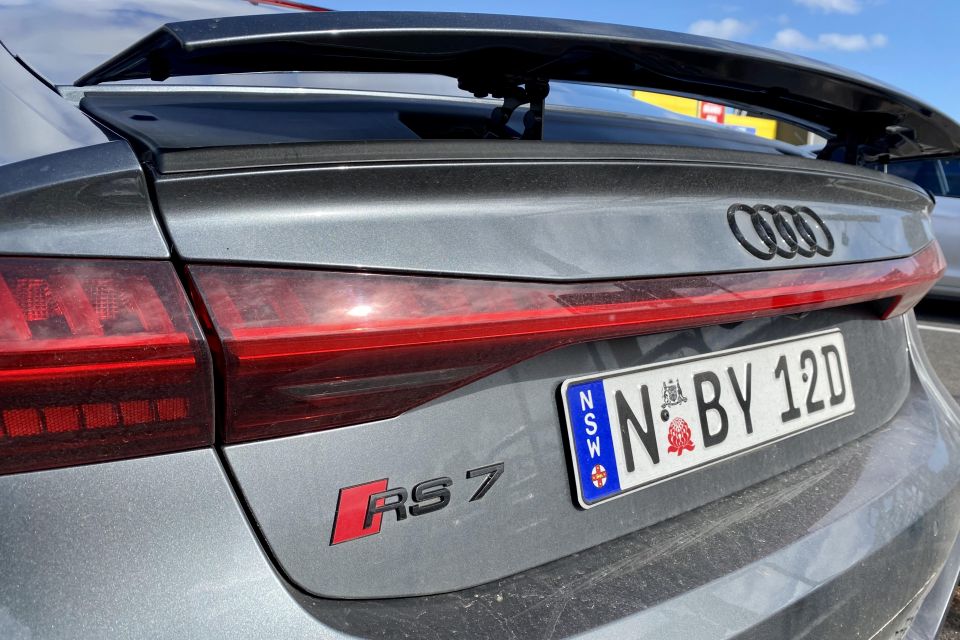
Buy your new car without the stress. It's fast, simple and completely free.

Great service from Travis and team, second time I have used this business would not hesitate to recommend them to anyone
Craig C.
Purchased a Ford Ranger in Sunshine Coast, QLD
CarExpert helped Craig save thousands on his Ford Ranger, now let us save you on your next new car.
Find a dealIf I wrote down the full list of features, this review would be 11,000 words and you’d need a refreshing doze to get you through. So let’s just list some highlights.
There are 22-inch five-spoke alloy wheels, a proximity key, an electric tailgate, HD Matrix LED headlights with laser lights and dynamic scrolling front and rear indicators, privacy glass with acoustic glazing, a panoramic glass sunroof, branded projecting puddle lamps, power-assisted door closure, and an electronically deployed active rear spoiler.
Inside there’s ‘Valcona’ leather trim, heated and ventilated front bucket seats, changeable coloured ambient cabin lighting, a windscreen head-up display, fully digital instrument cluster, electric steering column adjustment; Nappa leather on the console, dash and doors, and four-zone climate control with rear-seat adjustments.
Infotainment is displayed on a 10.1-inch touchscreen and includes conversational voice control, maps with online traffic updates, digital radio, wireless Apple CarPlay, wired Android Auto, wireless charging; and a Bang & Olufsen 3D sound system with 16 speakers, a 15-channel amp, and a 705W output.
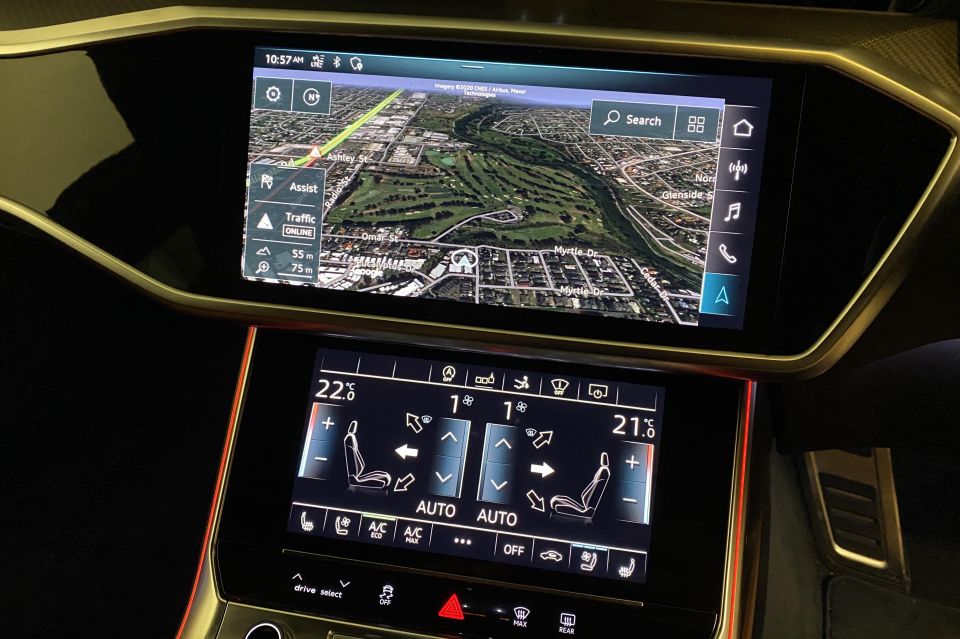

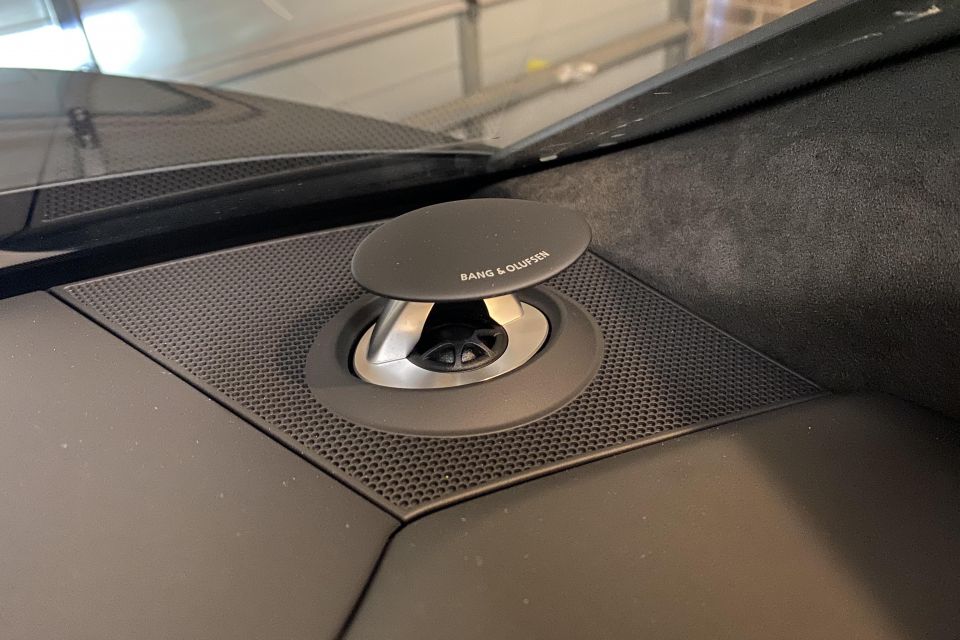
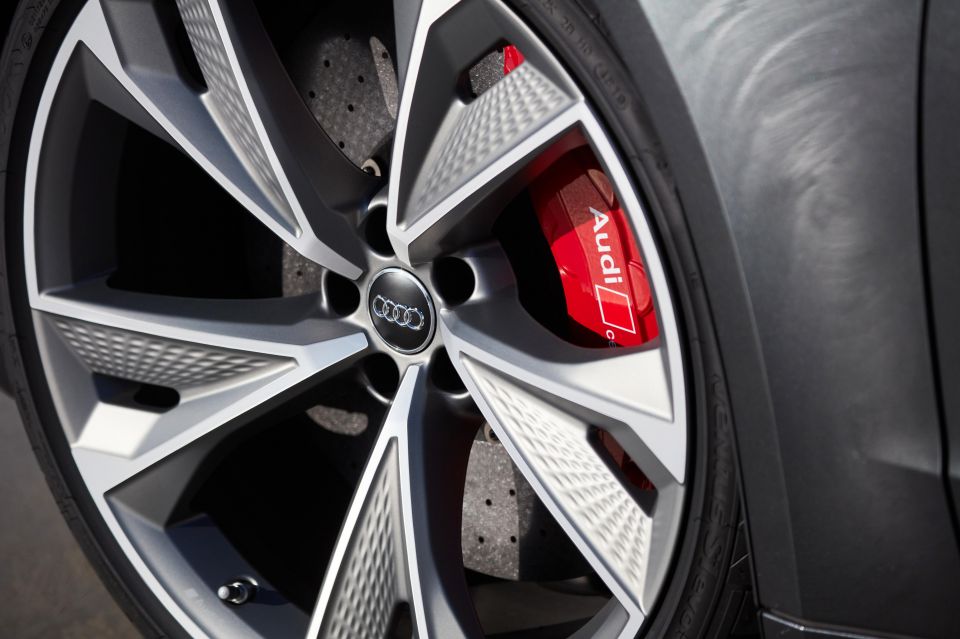
You can also remotely unlock your car, locate it, or get hold of roadside assist through an Audi app linked to your vehicle.
Our test vehicle was fitted with various extra-cost options. While the RS7 comes standard with adaptive air suspension, ours was fitted with RS Sports Suspension with Dynamic Ride Control to the tune of $2850.
Ours also had the $11,000 Sensory Package that adds a beautiful Alcantara headlining, an even more potent B&O audio system with 19 speakers and 1820W output, a leather steering wheel centre piece, rear-window sun shades, and heated back (outboard) seats.
Finally, our car had the $19,500 RS Dynamic package that adds uprated brakes – ceramic, measuring 440mm at the front and 370mm at the rear – that cut 34kg in weight. This package also brings red callipers and increases the top speed from 280km/h to 305km/h. If only we had Autobahns…
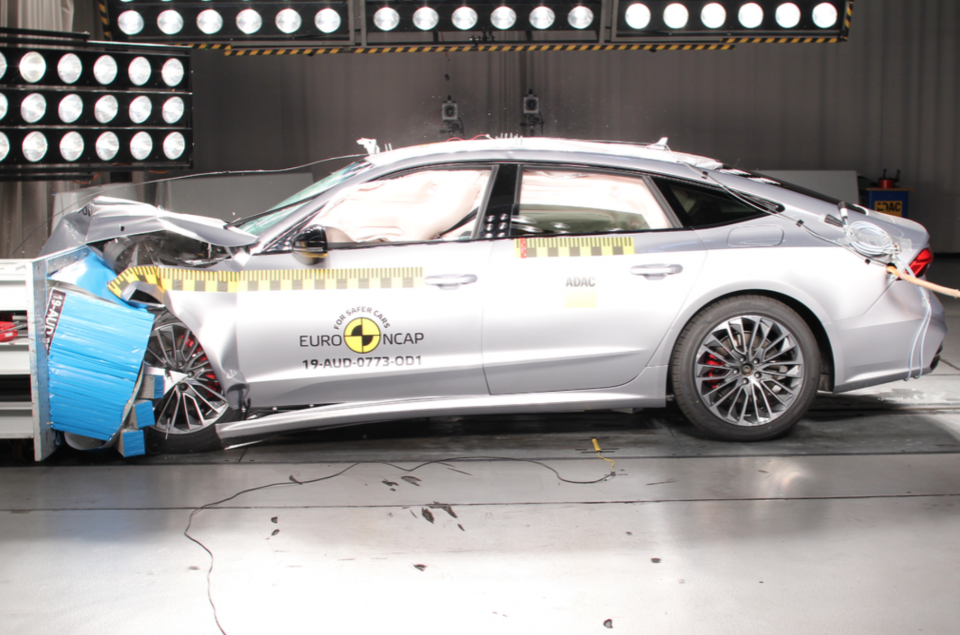
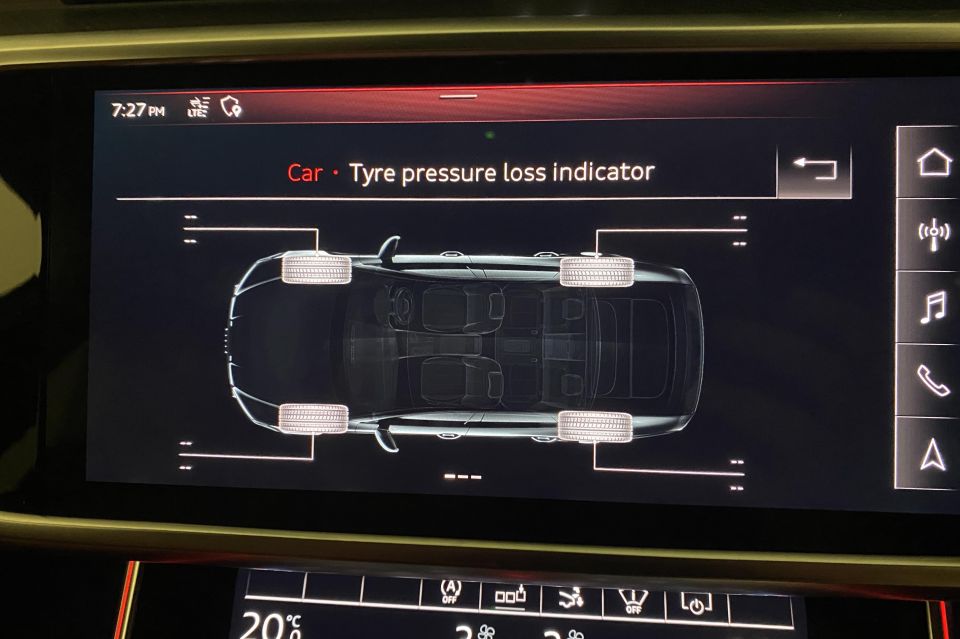
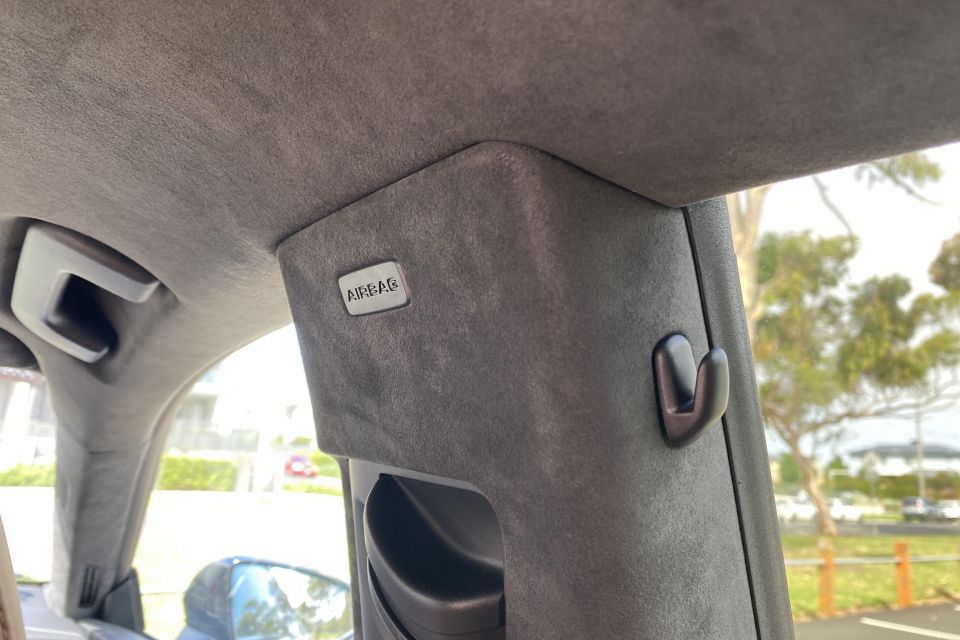

The regular Audi A7 on which this fire-breathing RS7 is based scored a five-star ANCAP crash rating in 2018 – managing 93 per cent for adult protection, 85 per cent for child protection, 81 per cent for pedestrian/cyclist protection, and 78 per cent for safety assist.
This rating doesn’t cover the RS7 but serves as a reasonable guide.
The basic safety systems fitted include six airbags (front, front-side, two-row curtains), an active bonnet, and driver-attention assist.
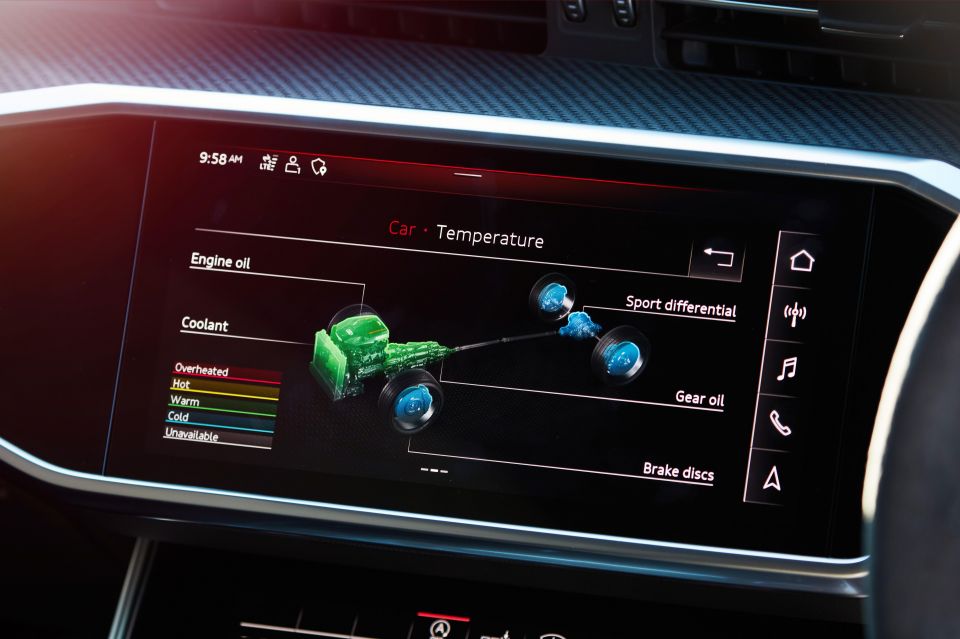
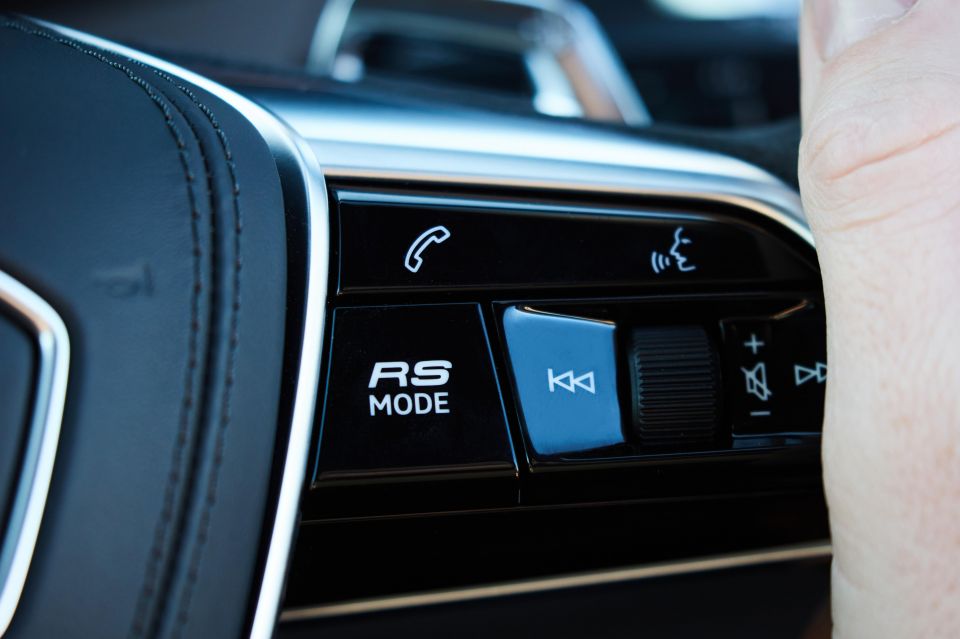
Active safety functions include adaptive cruise control that can stop the car, active lane-keeping assist with steering intervention, blind-spot monitoring, a 360-degree camera view, autonomous emergency braking (AEB) with pedestrian and cyclist detection, AEB that works at junctions, and rear cross-traffic assist.
There’s also an exit warning function that alerts you if you’re about to open your door into an oncoming cyclist or vehicle.
Essentially, on a highway the RS7 can steer between road lines before jolting you into paying attention, brake or speed up to match the speed of a car ahead of you, and come to a halt in emergencies. Basic partial autonomy with human intervention, then.
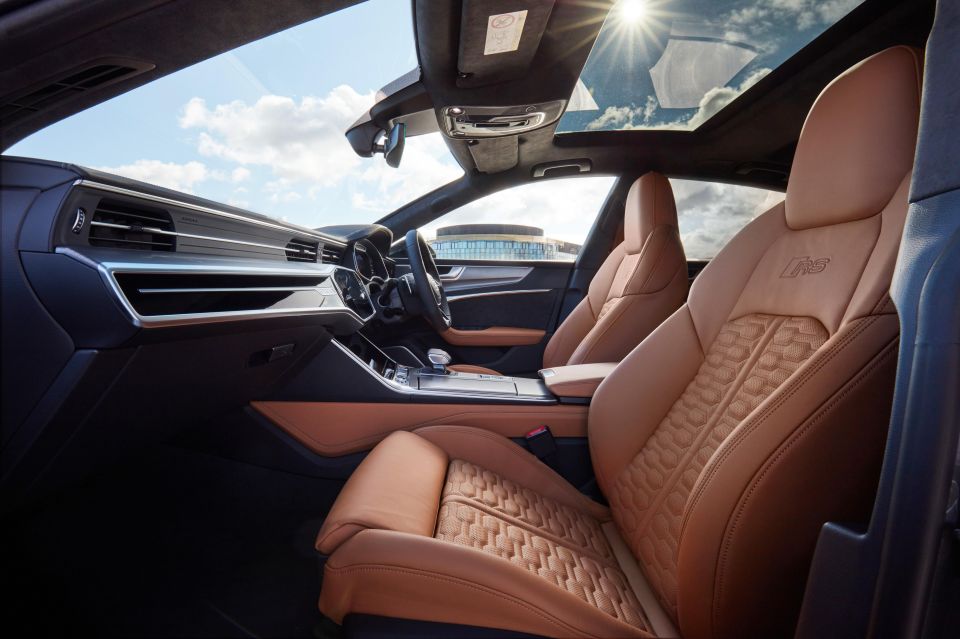
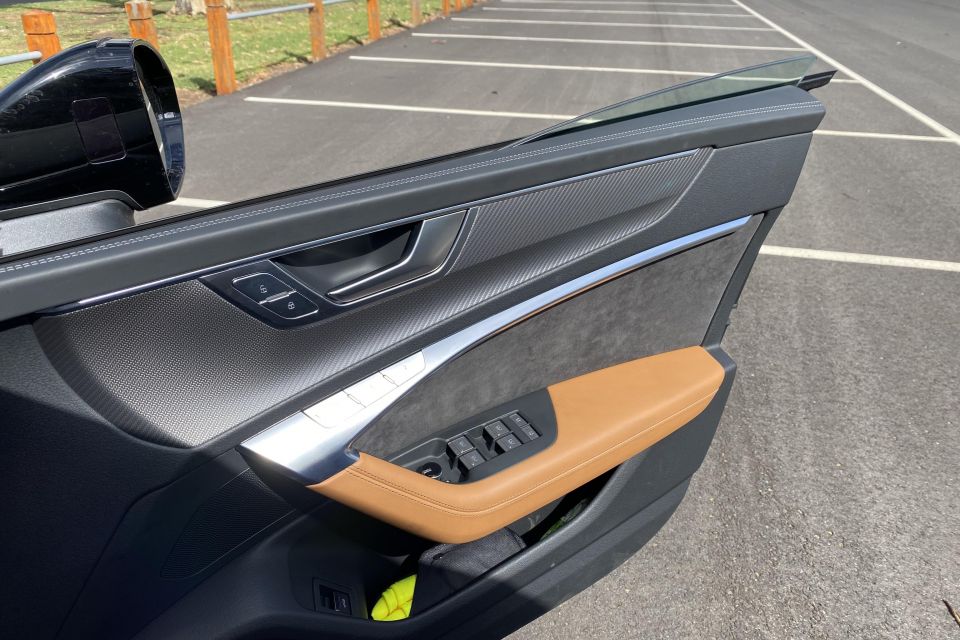

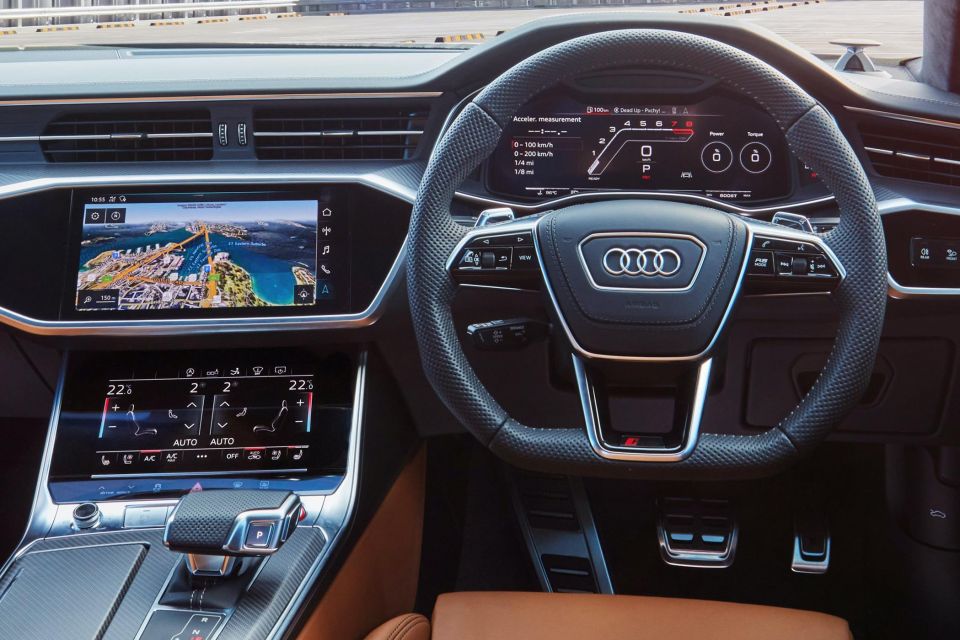
The tan leather fitted to our test car is an acquired taste, but regardless it’s of superb quality and the pews are highly supportive without losing their comfort. The illuminated seatbelt buckles are an inspired idea in a dark garage, too.
The dimpled leather steering wheel isn’t too thick in the rim, and the fitted cruise control stalk minimises the use of buttons on each spoke to some degree. The electric column adjustment allows anyone to get comfy, and the steel-capped pedals are perfectly placed.
The digitised instrument cluster is highly configurable, showing you basic approximations of analogue gauges but also able to display detailed maps, performance data, audio functions… whatever you like.
This screen is augmented by a large projecting head-up display that beams your speed and turning signals onto the windscreen, allowing you to keep your eyes on the road where they belong.
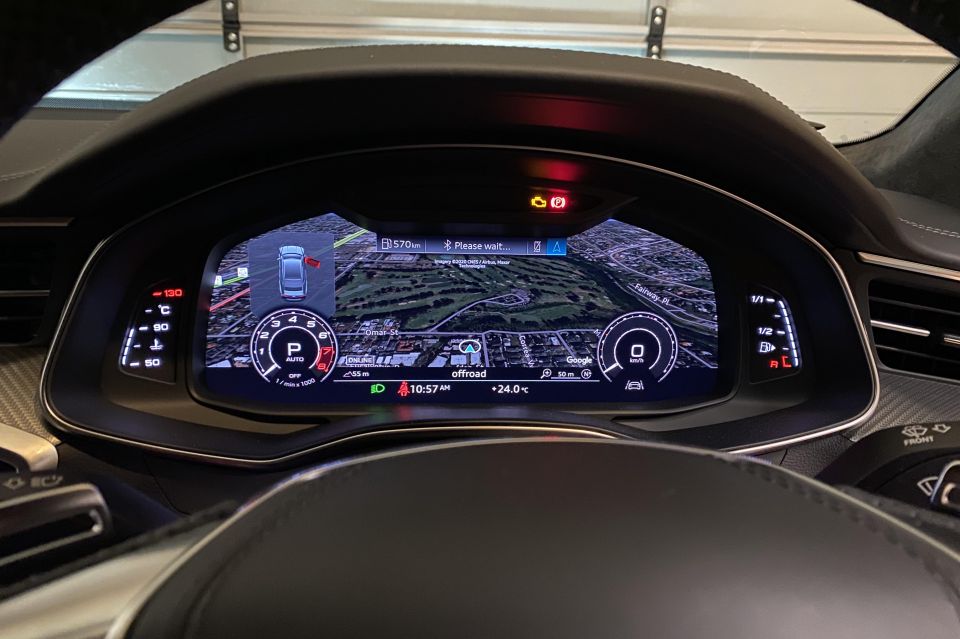
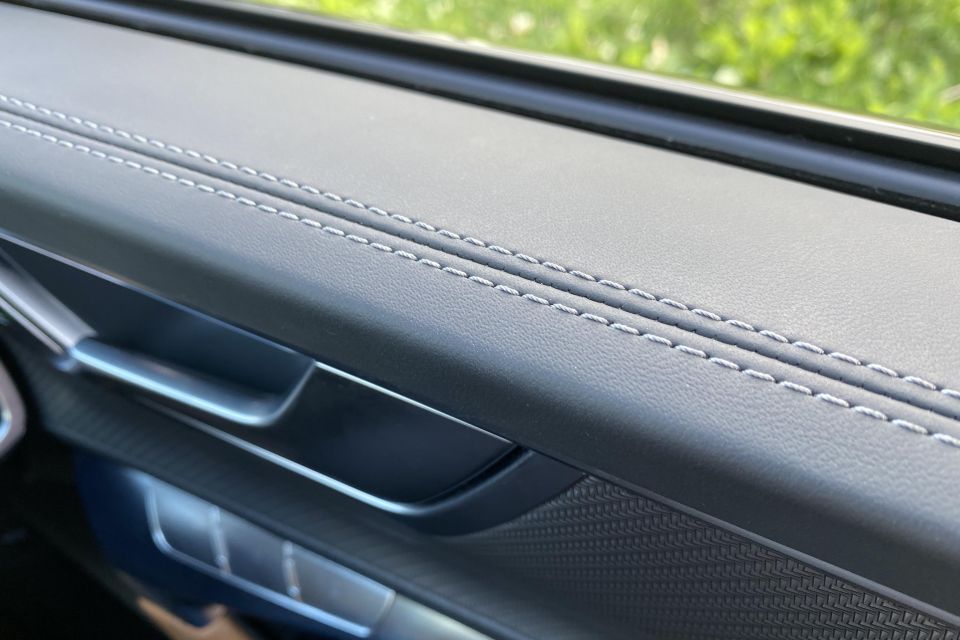
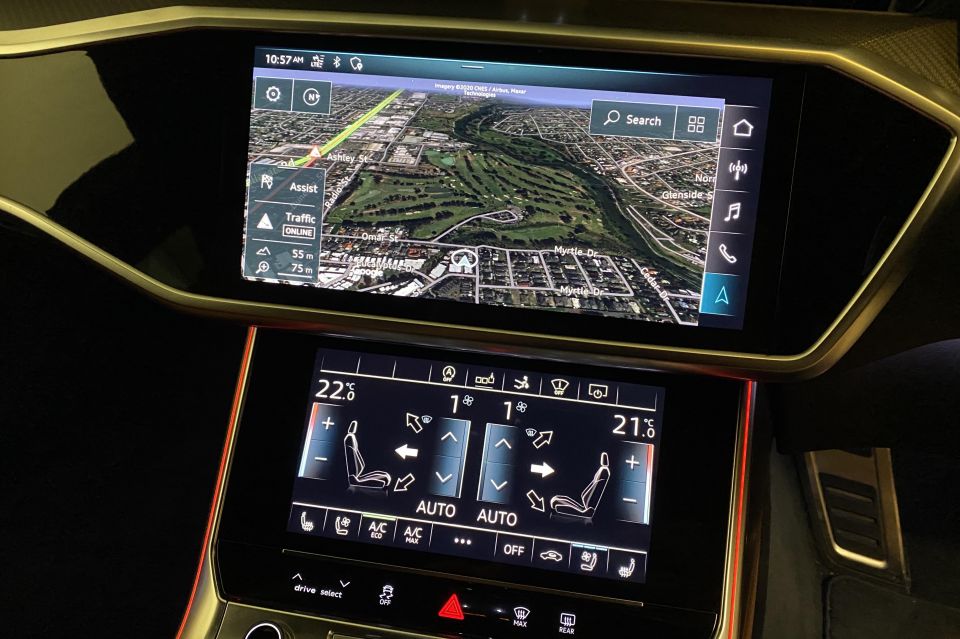
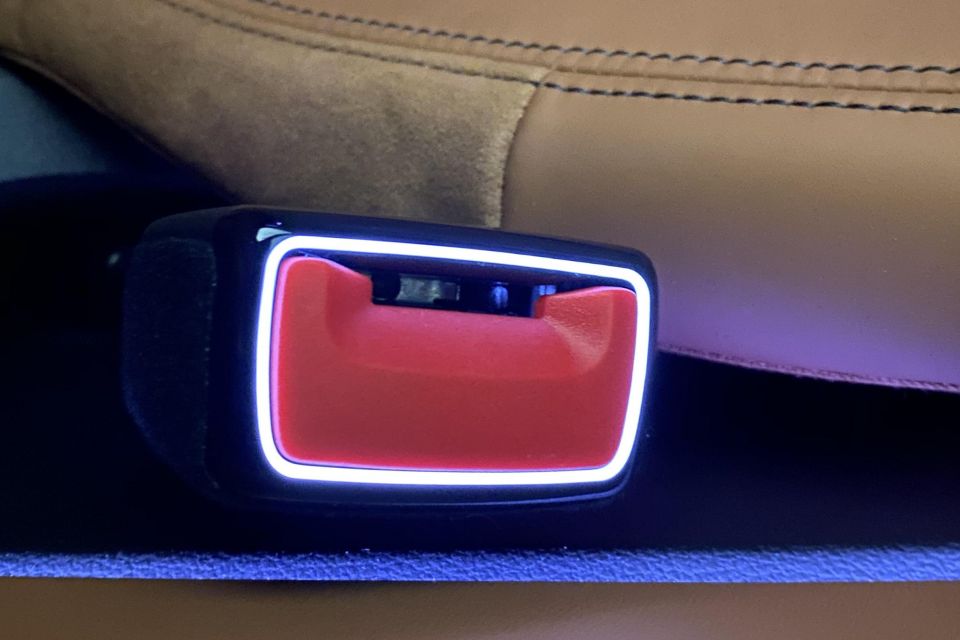
The centre touchscreen is super high-resolution – particularly with mapping – and the operating system isn’t hard to figure out. There are no hard buttons (bar a volume knob mounted lower on the fascia), but there’s a vertical shortcut bar with haptic feedback.
Below this is a smaller touchscreen with buzzy haptic feedback to control ventilation. There are also touch-sensitive areas to manually deploy the rear spoiler, turn off the stop/start, or fettle the seat heating and ventilation settings.
The double touchscreen approach isn’t intuitive on paper, but the haptic feedback gives you a semblance of the analogue feel required. I will say, though, that Audi would do well to furnish you with a few cleaning cloths because the twin screens get smudged really quickly.
There’s also excessive lashings of glossy black trims all over the place, which acts as a magnet for smudges, dust, hair, and sun glare. You may think I sound pedantic but it does water-down the gorgeous aesthetic.
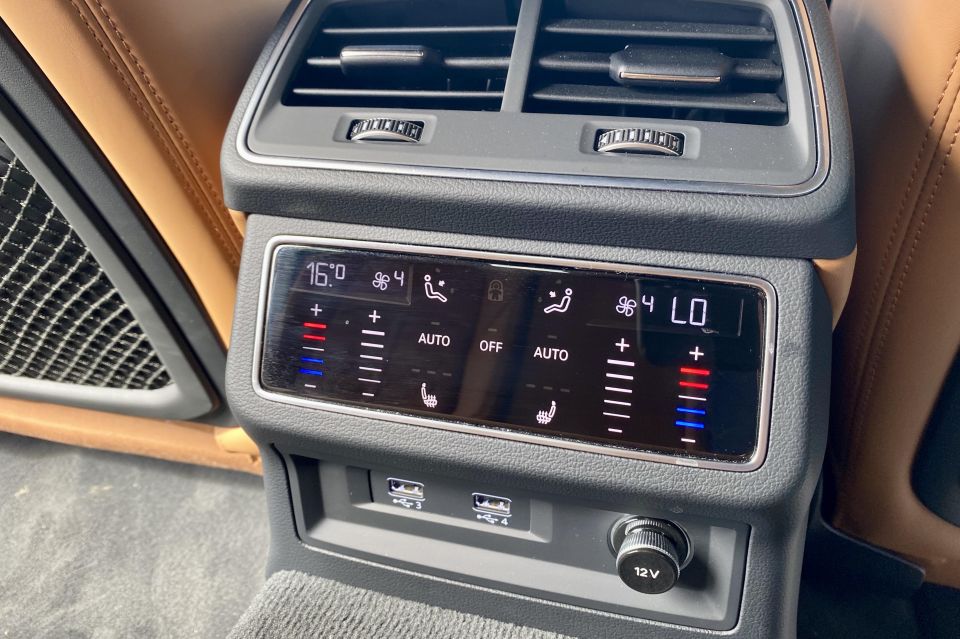
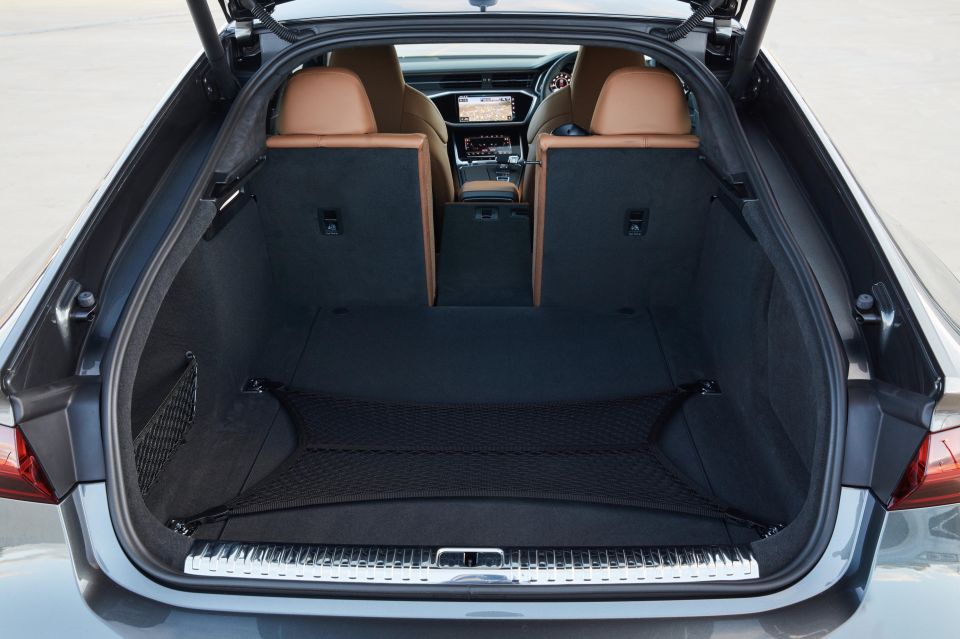

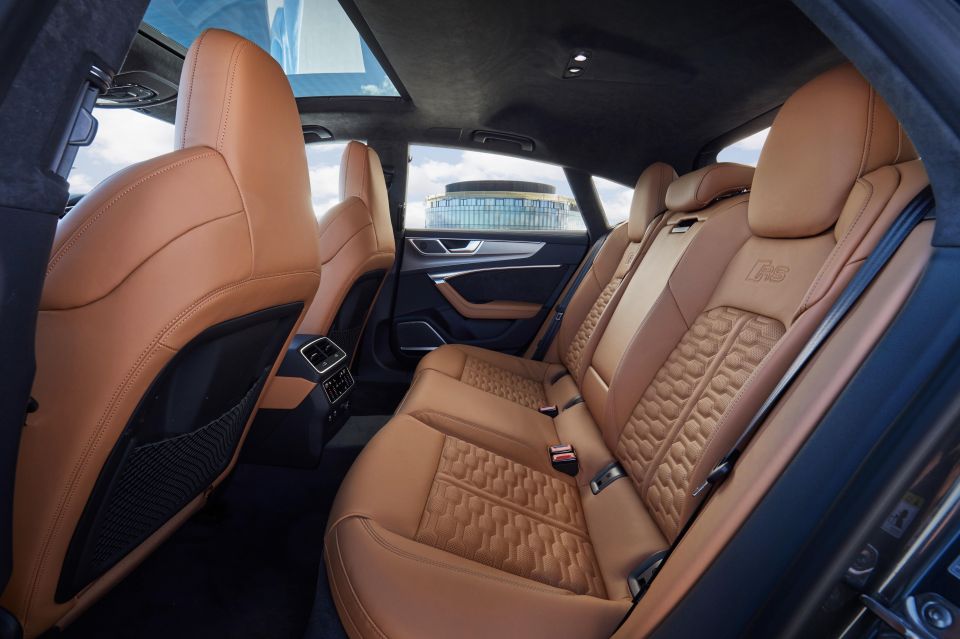
Otherwise, the build is phenomenal. All Audis are made with Teutonic pride, and the RS7 doubly so. Everything is solid as a rock, the metallic and felt materials are well chosen, the buttons damped, the roof lining soft to the touch, the stitching real, the carpets plush… timeless quality.
The back seats are trimmed with the same detail as the front, ditto the doors. There are’s also a digitised pad behind the console to control rear ventilation and seat heating, below which are two USB points. Overhead there are LED lights.
This is a long car – a whisker above five-metres nose to tail – and rear passenger legroom is generous. However, the sloping roof and big panoramic glass do eat into headroom if you’re as tall as I am (194cm).
The sizeable 535-litre boot is just 30L less capacious than the RS6 Avant’s boot and line-ball with the Audi Q5 SUV’s, and the hatchback aperture is large, expanding to 1390L with the back 40:20:40 seats folded flat. The boot lip is 650mm above the ground.

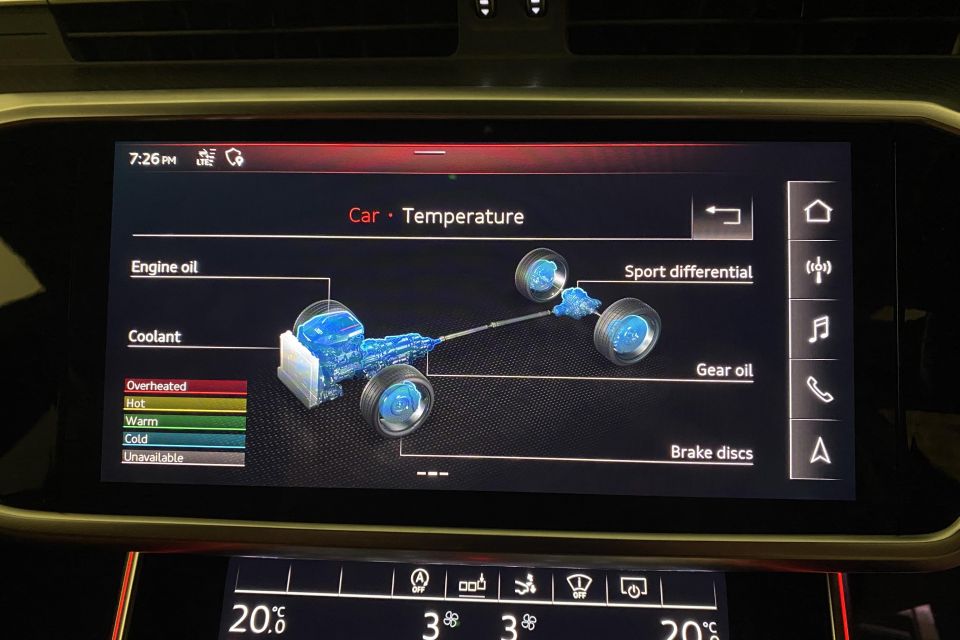
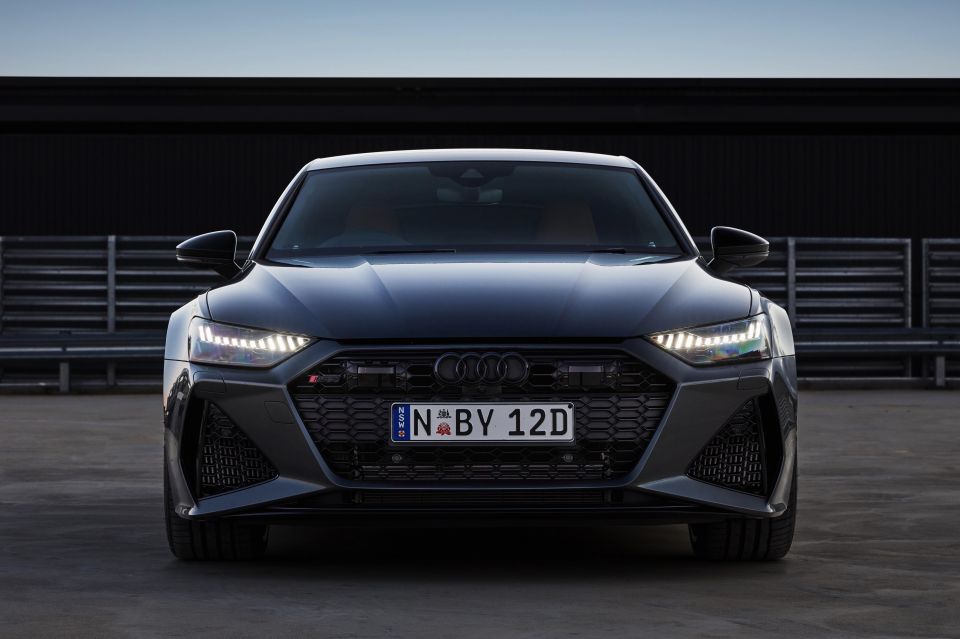
Now we get to the best bit: that engine. It’s a 4.0-litre V8 with two twin-scroll turbochargers fitted between the two 90-degree cylinder banks. Each blower feeds a bank apiece with up to 1.4 bar of boost pressure.
Audi touts the aluminium crankcase that weights 39kg, plasma-coated cylinder linings, variable camshafts (exhaust and intake), twin high-pressure fuel pumps, and a fully variable oil pump. It also has a petrol particulate filter, so when Audi says 98 RON is essential, it means it.
The engine pushes out 441kW of peak power right up at 6000rpm (the redline begins at 7000rpm), and 800Nm between 2050 and 4500rpm. The final-run 2017 RS7 Performance’s 4.0 TFSI engine made 445kW and 700Nm, to give you some context. This efficiency-led power cut is made up for with 100Nm more torque, I’d argue.
Obviously, engine outputs are sent to the road via a Quattro permanent and variable-torque-split all-wheel drive (AWD) system with a 60 per cent rear axle bias starting point. Since no Audi brand DCT can handle so much torque, Audi uses an eight-speed ‘tiptronic’ torque-converter automatic.

The recorded zero to 100km/h sprint time is a mere 3.6 seconds, and you’ll hit 200km/h (on a race track, guys), in 12 seconds. That makes this two-tonne limousine as fast off the mark as a Porsche 911 Carrera 4S.
While no force-fed V8 is environmentally friendly, there are some green tokens including a 48V electrical system (starter-generator) that smooths out the stop/start by activating it while the car is rolling, a motor that can recuperate 12kW of power, and cylinder-on-demand that shuts down half the cylinders when you’re cruising along.
Audi cites combined-cycle fuel consumption of 11.6L/100km on the combined cycle (16.3L/100km in urban driving, 8.9L/100km on highways). This is higher than the old RS7’s claim, but this new RS7 has been tested against the harsher WLTP regimen so it’s not apples-for-apples.
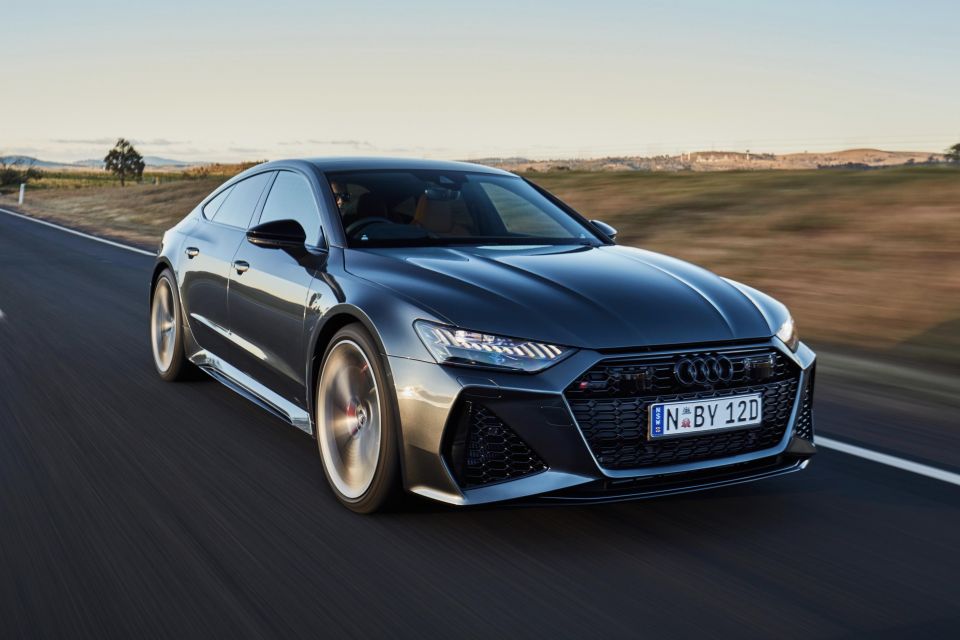
The engine burbles into life with a muffled woof that’ll keep the neighbours off your back. Its refinement and Audi’s ability to subdue any manic tendencies make the RS7 a consummate daily driver. In comfort driving mode, the stop/start is smooth, the shifts syrupy, and vibrations negligible.
But there’s a vast reservoir of grunt there, on tap the microsecond you request it with your right foot. Turbo lag belongs to the 20th century, and the pace at which this 2.2-tonne monster hurtles towards the horizon would be alarming – if the cabin were’t so bloody good at cosseting you.
Put the car into dynamic mode via the drive select buttons below the AC screen, and the instruments change, the gearbox holds lower ratios that bit longer, and the RS sports exhaust gets the memo.
That subdued muffle turns to a deep, brawny bark. Cue Wagnerian overtones playing at the back of one’s mind, though in isolation I must suggest that Mercedes-AMG’s 4.0-litre bent-eight might manage some even more existentially terrifying warbling.
Want to hear the engine, by the way? We put the mechanically identical RS6 Avant through its paces on a drag strip in the video below:
The pace available is both intoxicating and a little scary, on account of this car’s sheer size and mass. But while it can’t entirely shrink around you, Audi’s engineers have done a tremendous job of taming the beast.
The Quattro AWD system can allocate up to 85 per cent of engine torque to the rear axle which, from there, is variably allocated to each wheel through another differential. This mitigates push-understeer, but the rear bias doesn’t degrade into twitchiness. It really does drive on rails – wide ones, given the front and rear wheel tracks are so exaggerated.
It also has an all-wheel steering system whereby the back wheels turn a few degrees in the same direction as the fronts at speed to aid stability, and in the opposite direction at low speeds to slash the urban turning circle. The motor-driven steering also loads up with far more resistance at a clip, yet remains pinky-finger-friendly at urban speeds.
Straight-line speed is one thing, but stopping is another. I can’t imagine the standard steel brakes (10-piston front calipers and 420mm front discs, 370mm the rear) are undercooked, but the optional ceramic stoppers (available with red, blue or grey callipers) seem to defy physics.
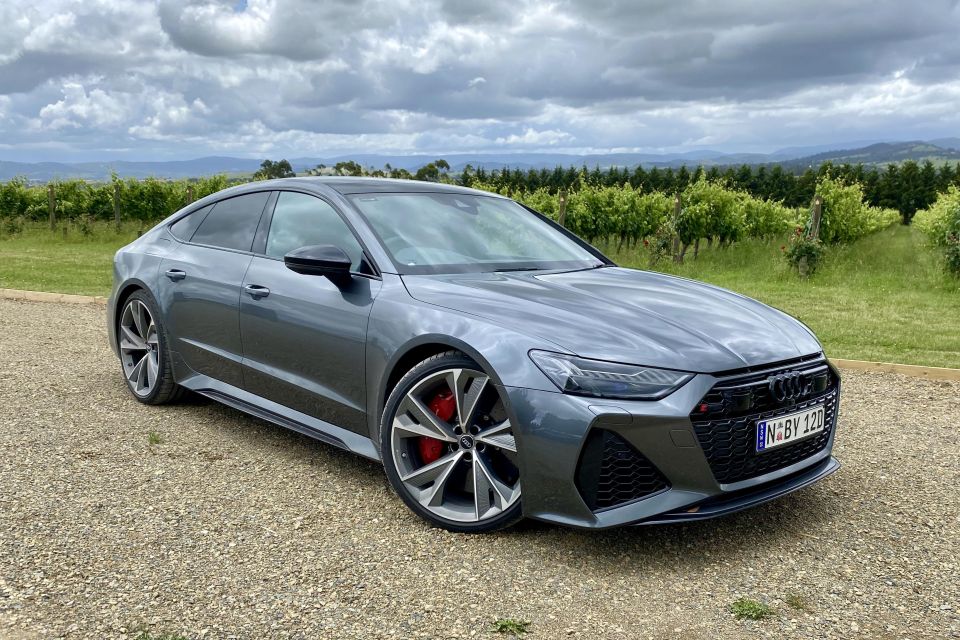
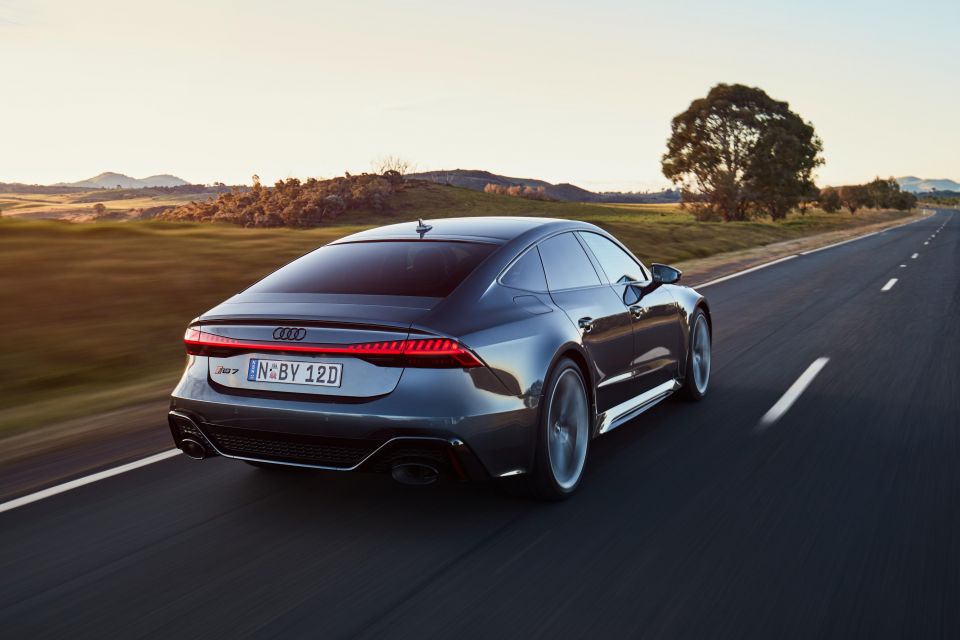
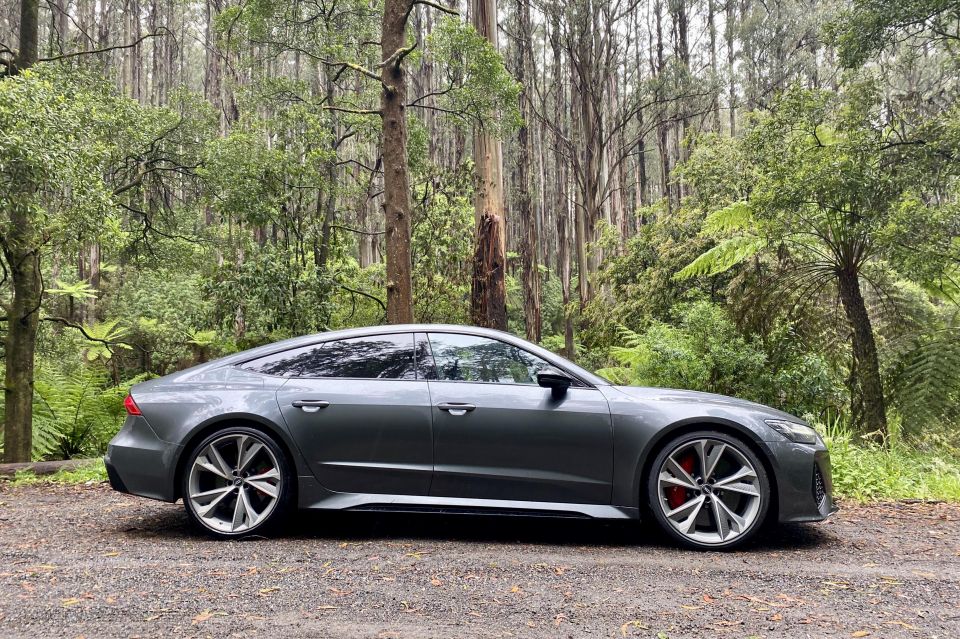
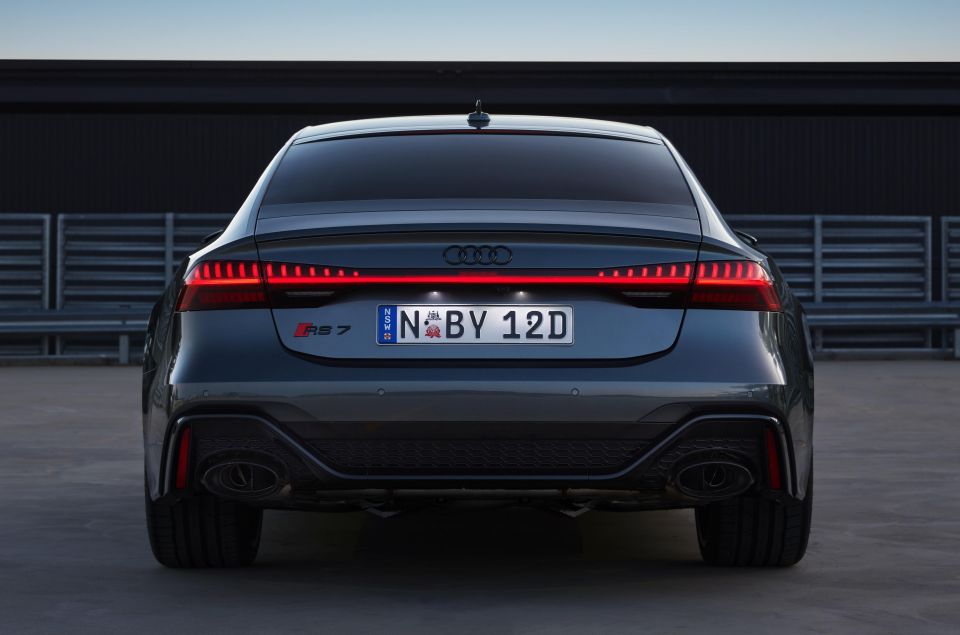
However, if you’re not a regular track driver who loathes brake dust, it’s hard to recommend spending the nearly $20,000 option price for a daily driver. Unless you want to gloat about doing precisely that!
The standard height-adjustable adjustable air suspension seems a great idea given the 22-inch wheels and liquorice-strap tyres offer as much bump isolation as a piece of tracing paper.
But our car instead used Dynamic Ride Control with three-stage variable, diagonally-linked mono-tube dampers that take on more or less force via hydraulic lines and a central valve. This is designed to reduce pitch and roll even further.
What surprised me was how reasonable the urban ride quality felt, especially in its more subdued resistance setting. It’s not a floaty luxo barge, but you don’t need to fear losing your fillings if you find yourself on a cobbled stretch or corrugated gravel. I’m no engineer, but I’ll tip my cap to those who worked on this setup.
Personally though, I’d think sticking with the standard air suspension would be the go. The RS7 is a daily driver, and chambered suspension seems a more rounded companion for most purposes.
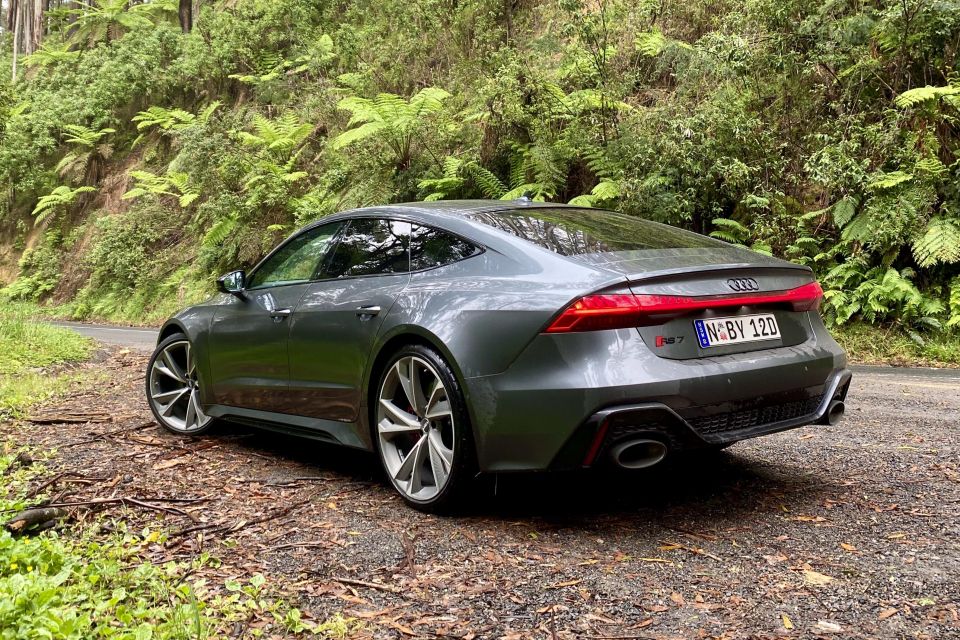
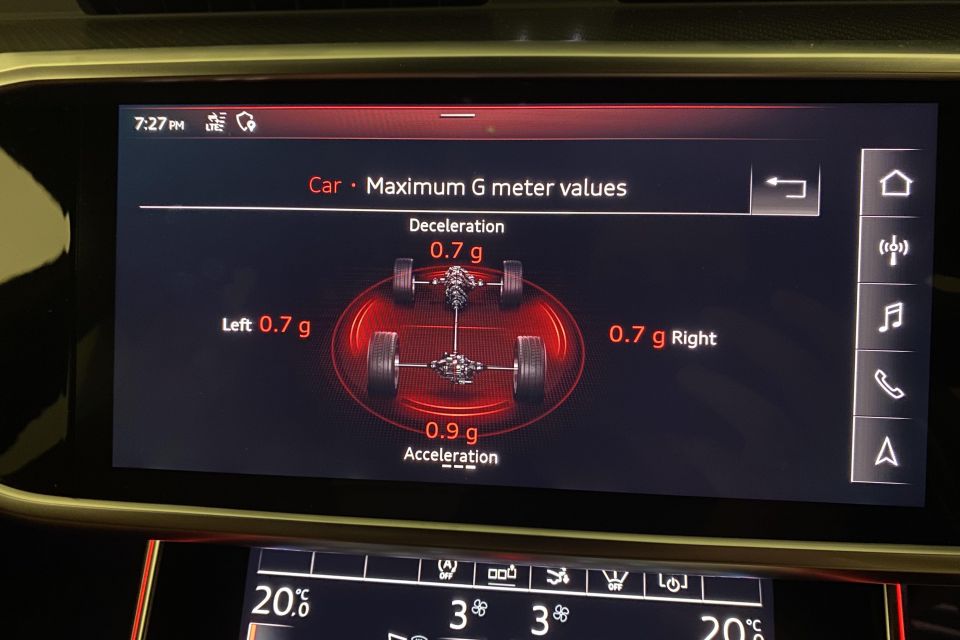
Where expert car reviews meet expert car buying – CarExpert gives you trusted advice, personalised service and real savings on your next new car.
To be frank, spending time on public roads in this thing stretched it to about two-tenths of its capabilities. Which is why its respectable comfort and ability to control those outputs when desired struck me as so impressive.
There’s a ferocious monster lurking within, but caged behind a friendly face as long as you want it to be.
Audi offers a shorter-than-average three-year, unlimited-kilometre warranty on all new cars, and RS7 owners can purchase a five-year plan for $3910. That covers five years or 75,000km including perishables.
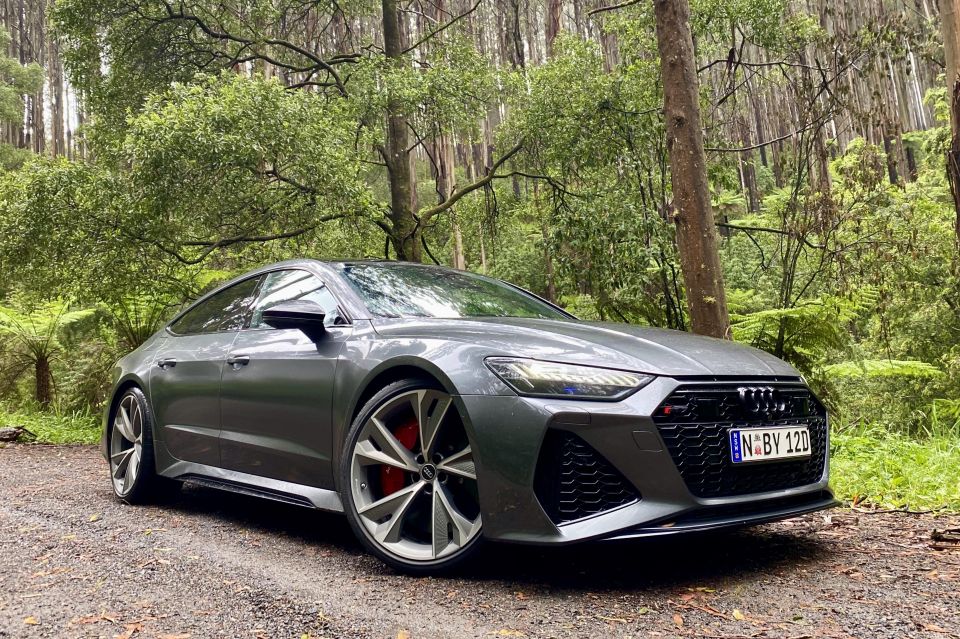
I didn’t drive a more compelling car in 2020, and I’m no Ingolstadt tragic. I’ve heard from some that it’s not as feral on track as the equivalent AMG or BMW M Division luxury barges, but the RS7’s dynamic might, gorgeous design, and flawless build ticked all of my boxes.
Be prepared for a technologically sophisticated supercar capable of ferrying four adults and their luggage in comfort. I wouldn’t bother with the $34,000 of options on our test car either, the starting point is more than sufficient.
Indeed, the Audi RS7 Sportback is a powerful magnet for attention, so be prepared to discuss its pros and cons with passersby at length. It’s even less subtle than the RS6 Avant, but all the more memorable for it.
Click the images for the full gallery
Where expert car reviews meet expert car buying – CarExpert gives you trusted advice, personalised service and real savings on your next new car.


Matt Robinson
56 Minutes Ago


Damion Smy
56 Minutes Ago


Damion Smy
15 Hours Ago


Damion Smy
16 Hours Ago


Damion Smy
18 Hours Ago


Damion Smy
19 Hours Ago